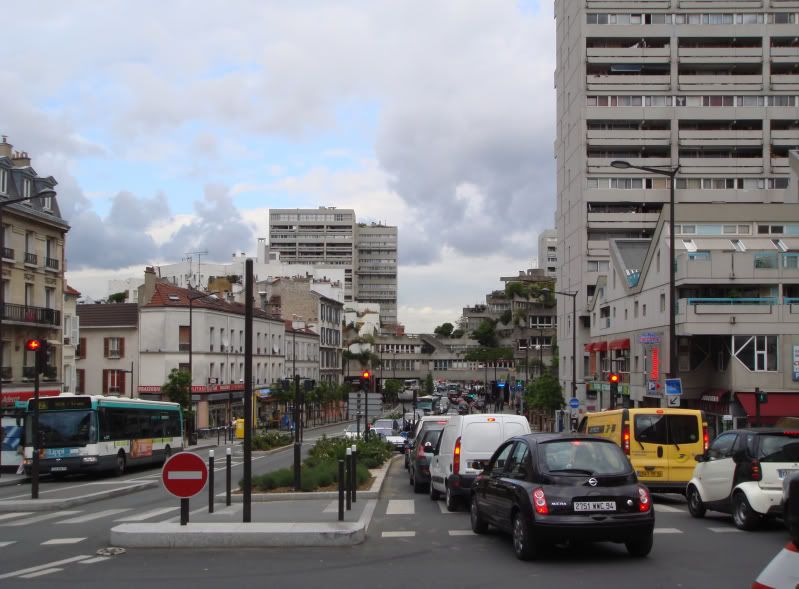 The town of Ivry-Sur-Seine lies just beyond the southeast end of Paris, on the south side of the city's 13th arrondissement. Ivry, like most of Paris' dreary suburban satellite towns, has very little attraction for non-residents, and as a whole does not seem particularly interesting. Its downtown however, happens to possess what I think is one of the most fascinatingly enigmatic architectural ensembles to be found anywhere in the world.
The town of Ivry-Sur-Seine lies just beyond the southeast end of Paris, on the south side of the city's 13th arrondissement. Ivry, like most of Paris' dreary suburban satellite towns, has very little attraction for non-residents, and as a whole does not seem particularly interesting. Its downtown however, happens to possess what I think is one of the most fascinatingly enigmatic architectural ensembles to be found anywhere in the world.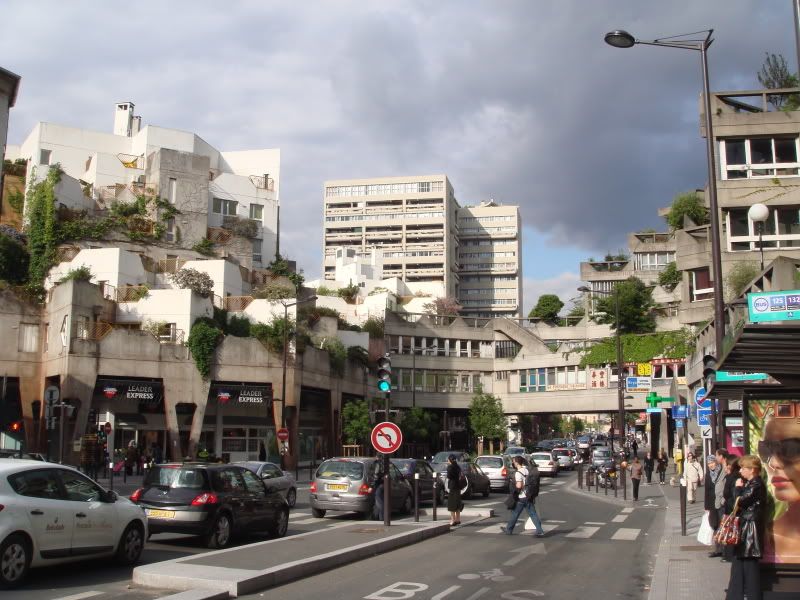 Between 1969 and 1982, Ivry's city center was nearly completely rebuilt via a series of grand redevelopment projects, almost entirely designed by the architect Jean Renaudie (1925-1981). Renaudie, upon graduation from the École des Beaux-arts, studied under one of France's early Modernist giants, Auguste Perret, before co-founding the Atelier de Montrouge in 1958. The firm worked within a fairly standard style of functionalist Brutalism in the vein of Le Corbusier, and quickly gained recognition among France's architectural community. Nonetheless, Renaudie soon tired of the functionalist creed of his peers, and began to devise a radically different vision of architecture and design. He left the Atelier de Montrouge in 1968, just in time to stumble upon the opportunity of a lifetime.
Between 1969 and 1982, Ivry's city center was nearly completely rebuilt via a series of grand redevelopment projects, almost entirely designed by the architect Jean Renaudie (1925-1981). Renaudie, upon graduation from the École des Beaux-arts, studied under one of France's early Modernist giants, Auguste Perret, before co-founding the Atelier de Montrouge in 1958. The firm worked within a fairly standard style of functionalist Brutalism in the vein of Le Corbusier, and quickly gained recognition among France's architectural community. Nonetheless, Renaudie soon tired of the functionalist creed of his peers, and began to devise a radically different vision of architecture and design. He left the Atelier de Montrouge in 1968, just in time to stumble upon the opportunity of a lifetime. Shortly after joining the architectural team behind Ivry-sur-Seine's downtown redevelopment plan that same year, Renaudie was handed complete leadership of the project and given the full freedom to finally put his theoretical designs into practice, an opportunity that surely did not go wasted. He devised a series of housing towers linked by pyramid-like complexes that fan outward in abundantly planted cascading terraces. In great contrast with his previous work, Renaudie largely abandoned right angles for a free use of horizontal and triangular forms.
Shortly after joining the architectural team behind Ivry-sur-Seine's downtown redevelopment plan that same year, Renaudie was handed complete leadership of the project and given the full freedom to finally put his theoretical designs into practice, an opportunity that surely did not go wasted. He devised a series of housing towers linked by pyramid-like complexes that fan outward in abundantly planted cascading terraces. In great contrast with his previous work, Renaudie largely abandoned right angles for a free use of horizontal and triangular forms.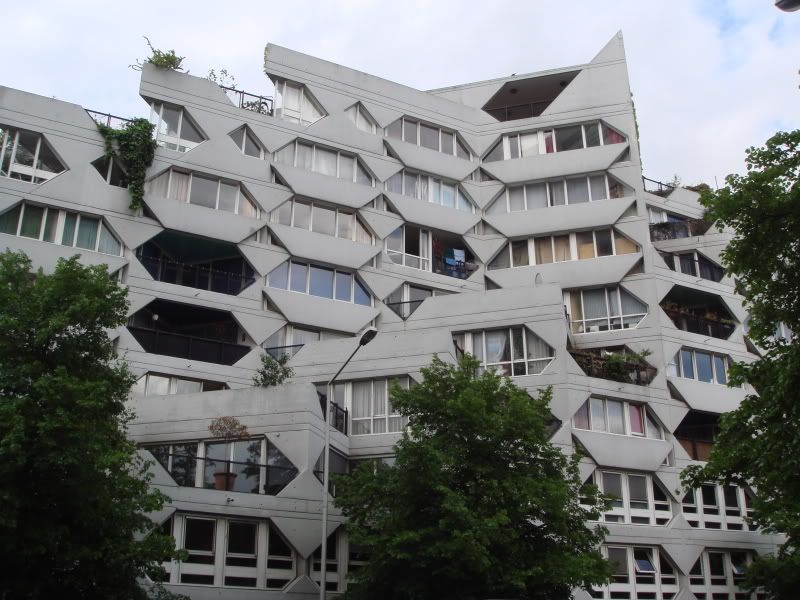 Each building represented a strong rejection of the entrenched currents of austerity and uniformity underlying Modernist architecture and planning. Renaudie's intricately arraged geometric volumes and winding passageways introduced an extreme level of intentional complexity and whimsicality, a reaction that slightly anticipated the coming wave of architectural Postmodernism. In a further break from Modernist city design, Renaudie reembraced traditional urban forms by incorporating street-level commercial space, arcaded sidewalks, and enclosed plazas. The towers rise up from the sidewalk with none of the grassy setbacks so characteristic of other mid-century highrise clusters around Paris (like the Olympiades complex, for example).
Each building represented a strong rejection of the entrenched currents of austerity and uniformity underlying Modernist architecture and planning. Renaudie's intricately arraged geometric volumes and winding passageways introduced an extreme level of intentional complexity and whimsicality, a reaction that slightly anticipated the coming wave of architectural Postmodernism. In a further break from Modernist city design, Renaudie reembraced traditional urban forms by incorporating street-level commercial space, arcaded sidewalks, and enclosed plazas. The towers rise up from the sidewalk with none of the grassy setbacks so characteristic of other mid-century highrise clusters around Paris (like the Olympiades complex, for example). Renaudie passed away in 1981 at the age of 56, and it is nothing short of astonishing that he was able to create such avant-garde work at such a great scale by that age. Of course, Ivry's 30-year-old downtown isn't without issues. At first glance, it's buildings are nothing short of a chaotic and intimidating jumble, overwhelming in their complexity. Its multi-level passageways and courtyard nooks, hidden from the street, are generally empty and feel incredibly unmonitored and unsafe. The aged concrete looks bleak, too many storefronts are shuttered, and on Sundays the deserted neighborhood feels a bit too much like a dystopian post-apocalyptic nightmare.
Renaudie passed away in 1981 at the age of 56, and it is nothing short of astonishing that he was able to create such avant-garde work at such a great scale by that age. Of course, Ivry's 30-year-old downtown isn't without issues. At first glance, it's buildings are nothing short of a chaotic and intimidating jumble, overwhelming in their complexity. Its multi-level passageways and courtyard nooks, hidden from the street, are generally empty and feel incredibly unmonitored and unsafe. The aged concrete looks bleak, too many storefronts are shuttered, and on Sundays the deserted neighborhood feels a bit too much like a dystopian post-apocalyptic nightmare.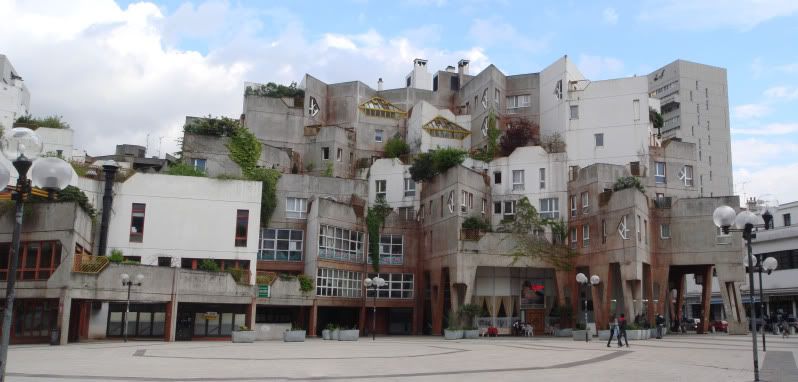 Nonetheless, Renaudie's achievement marks an interesting moment in the history of architecture, on the cusp between Modernism and Postmodernism. If anything, its defiance of simple characterization is rather remarkable, regardless of one's opinion on its aesthetics. The ensemble of rigidly sculpted volumes of exposed concrete scattered with overgrown terraces is a fascinating marriage of the geometric and the organic, of futurism and primitivism, unrivaled in its originality.
Nonetheless, Renaudie's achievement marks an interesting moment in the history of architecture, on the cusp between Modernism and Postmodernism. If anything, its defiance of simple characterization is rather remarkable, regardless of one's opinion on its aesthetics. The ensemble of rigidly sculpted volumes of exposed concrete scattered with overgrown terraces is a fascinating marriage of the geometric and the organic, of futurism and primitivism, unrivaled in its originality.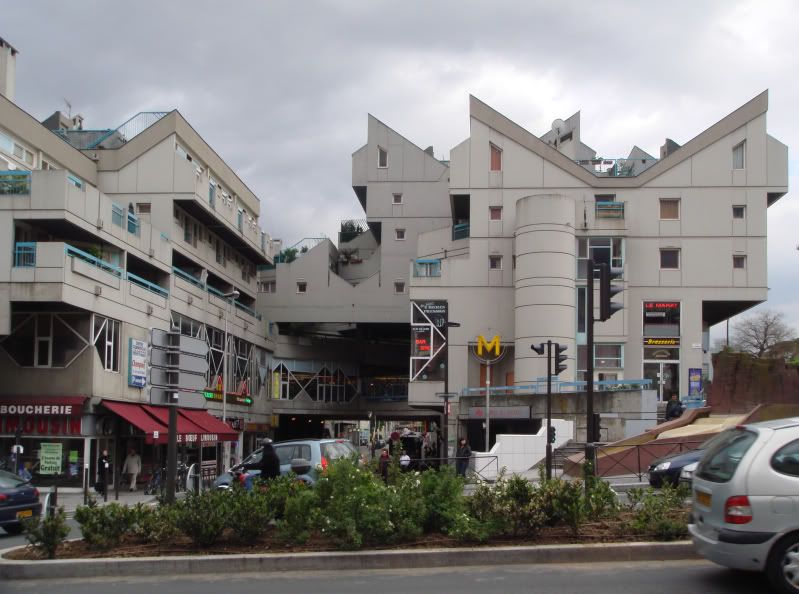 Sources:
Sources:1. http://www.humanite.fr/2002-11-02_Cultures_-Urbanisme-Ivry-sur-Seine-presente-le-travail-de-l-architecte
2. http://www.frac-centre.fr/public/collecti/artistes/renaudie/noti01fr.htm
No comments:
Post a Comment